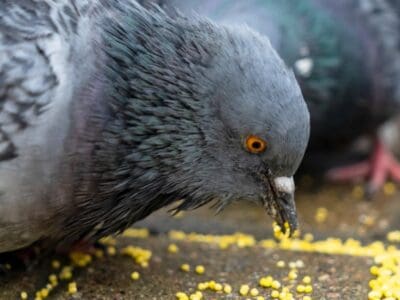Can grow up to 4ft long!
Advertisement
Glass Lizard Scientific Classification
- Kingdom
- Animalia
- Phylum
- Chordata
- Class
- Reptilia
- Order
- Squamata
- Family
- Anguidae
- Genus
- Ophisaurus
- Scientific Name
- Ophisaurus
Read our Complete Guide to Classification of Animals.
Glass Lizard Conservation Status
Glass Lizard Facts
- Main Prey
- Insects, Snails, Spiders
- Distinctive Feature
- Forked tongue and detachable tail
- Habitat
- Sandy coastal regions
- Predators
- Birds, Mammals, Snakes
- Diet
- Carnivore
View all of the Glass Lizard images!
“The glass lizard has no legs but is not a snake, making it a unique and interesting member of the reptile kingdom.”
The glass lizard is a legless reptile that’s native to North America. This intelligent lizard dwells everywhere between the rocky beaches of Florida to the grassy expanses of the Midwest. Hidden in these places, the Ophisaurus waits patiently for its prey: insects, spiders, and other small creatures that crawl in the damp spaces underground.
These lizards are known for having long tails that comprise most of their bodies. Although it’s possible for one of these tails to regrow if it gets broken off, the truth is that the new tail will have neither the same markings nor reach the same length as the original. Because of this, responsible handlers take great care to avoid harming any glass lizards they meet. These lizards are not known to bite humans if approached with a friendly attitude.
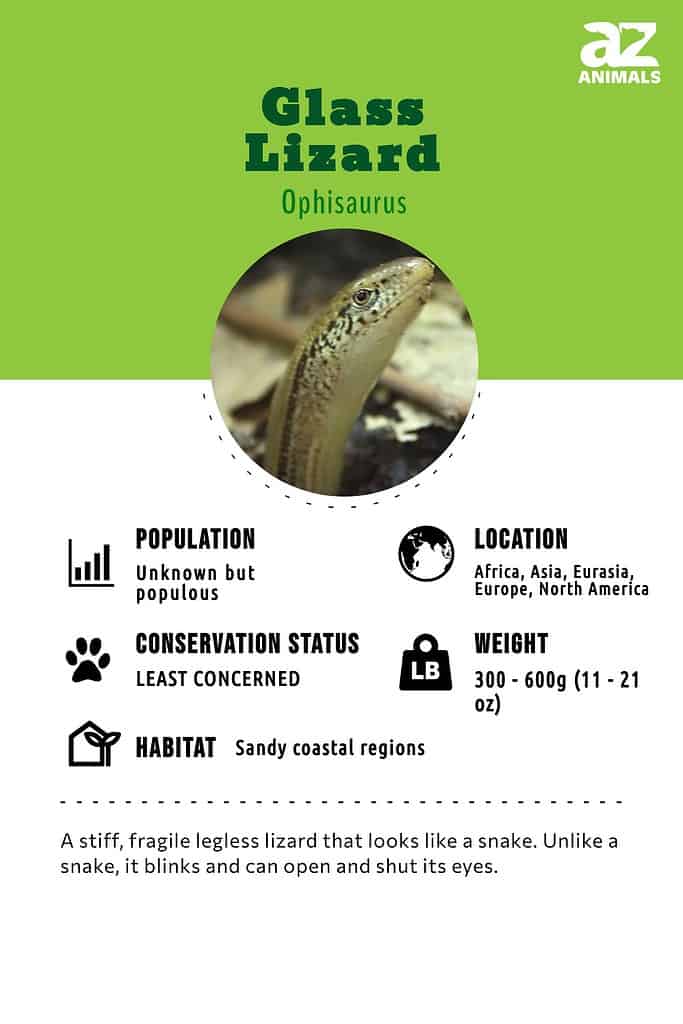
Luckily, Ophisaurus is a resourceful species that has managed to successfully spread across America’s warm and moderate climates. You can tell that you’re looking at a glass lizard if its eyes can open and close; this is something that a snake simply cannot do.
Incredible Glass Lizard Facts!
- Glass lizards have eyes that can open and close; that’s how you know they’re lizards and not snakes.
- Glass lizards are shy and squirmy, but they don’t usually bite humans, even when they’re picked up.
- Although glass lizards are legless, some of them have a small pair of legs located near their rear vents.
- Glass lizards’ tails break off as a survival mechanism when they are caught by a predator. The tail keeps squirming while the lizard gets away; later, the lizard’s tail will regrow.
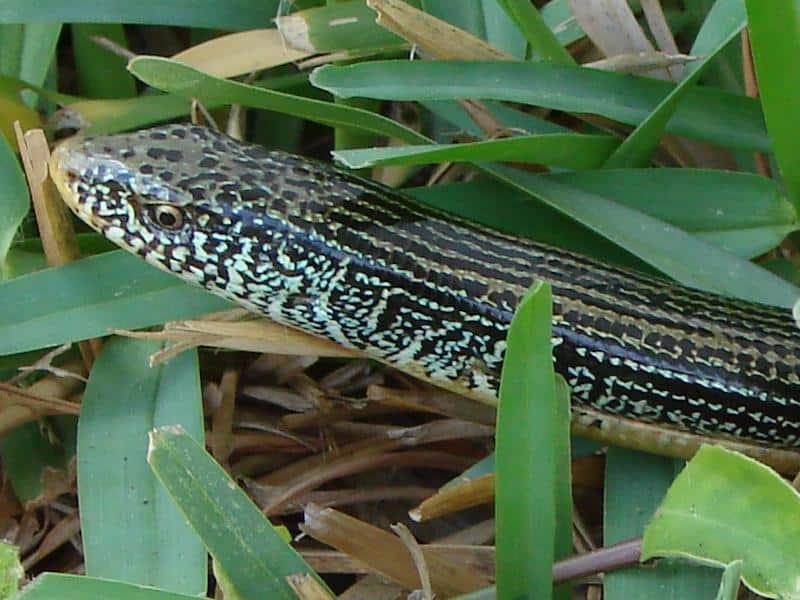
Glass lizards look like snakes – but they blink and can close their eyes.
©Fl295, Public domain, via Wikimedia Commons – License
Scientific Name
The scientific name of these lizards is Ophisaurus. This name is a combination of two Greek words: ophio, which means snake, and sauros, which means lizard. There are several different varieties of glass lizard scattered across the world, including:
- Ophisaurus ventralis: the eastern glass lizard
- Ophisaurus compressus: the island glass lizard
- Ophisaurus mimicus: the mimic glass lizard
- Ophisaurus attenuatus: the slender glass lizard
Ophisaurus attenuatus also contains the subspecies Ophisaurus attenuatus longicaudus, which are the longest and most slender glass lizards of all.
It’s worth noting that the term “glass lizard” can also be used to refer to members of the genera Dopasia, Hyalosaurus, and Pseudopus, which can be found in Asia, Africa, and Europe. Although these creatures are technically legless lizards, they are not actually related to members of the Ophisaurus genus.
Evolution
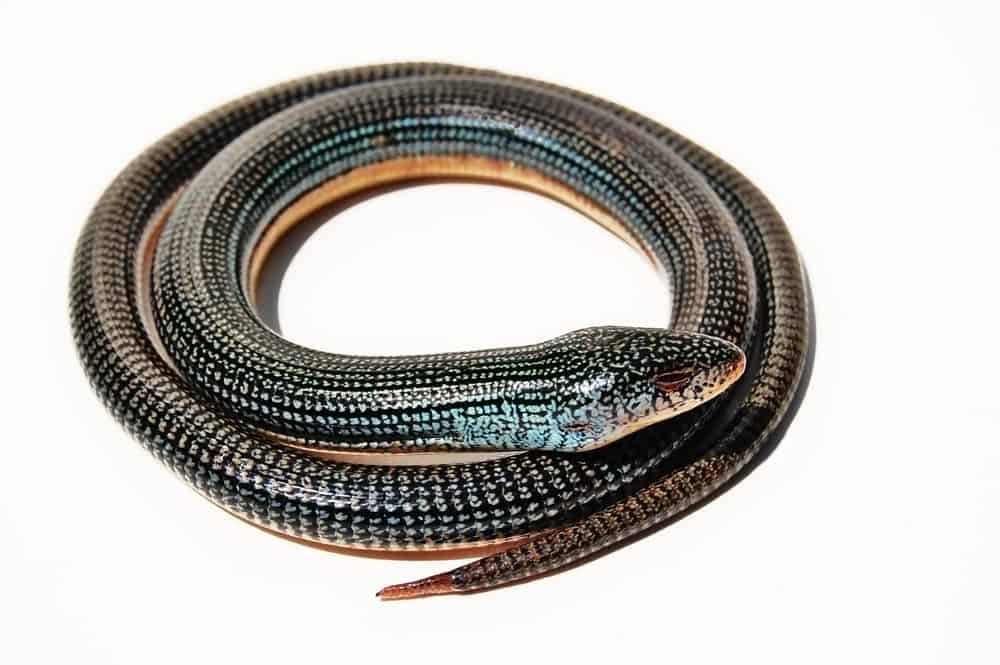
Glass lizards all over the world evolved leglessness independently of each other – this is called convergent evolution.
©eduard ionescu/Shutterstock.com
Glass lizards can not trace their lineage back to one ancestor from which they evolved. Instead, there are species of glass lizard all over the world that evolved leglessness independently of each other – convergent evolution. Over millions of years, these creatures developed smaller and smaller limbs until they just vanished. Some glass lizards still have vestigial back limbs next to their vents. Snakes actually evolved from burrowing or aquatic lizards during the Jurassic period, so glass lizards may be animals that never evolved into snakes but remained in a stage of development that suited their environments. The oldest fossil of a true snake has dated 167 – 143 million years ago.
Appearance
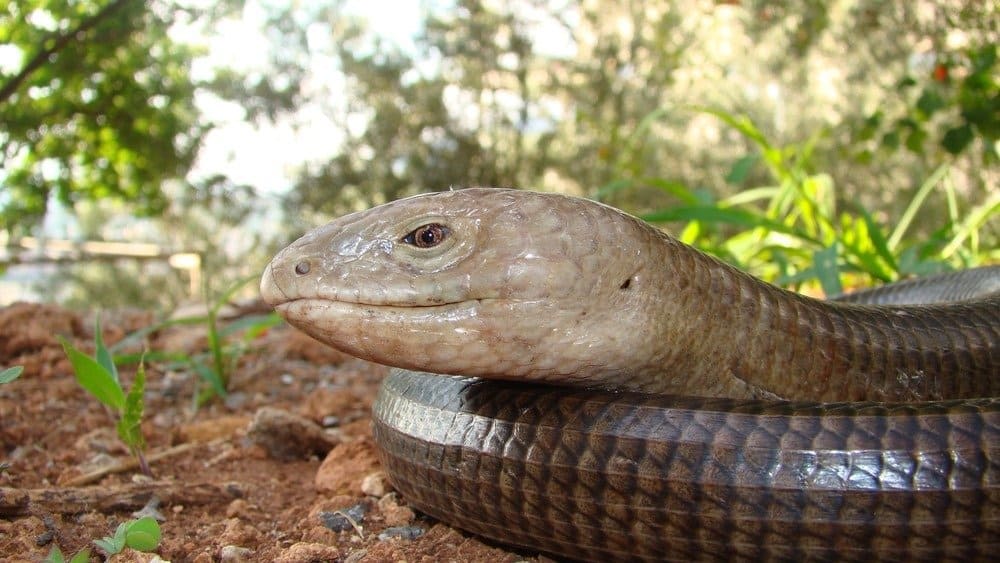
Almost two-thirds of a glass lizard’s length consists of its tail.
©Dr.MYM/Shutterstock.com
Glass lizards are long, thin reptiles that come in a variety of colors and patterns. Most glass lizards have brown or gray scales with light speckles and a yellow or cream-colored belly. Many of these lizards also have long, dark stripes on their sides that reach from head to tail. Ophisaurus patterns are regional and often help the lizard maintain camouflage in the local environment.
These lizards can grow anywhere between 2 to 4 feet (60 to 121 cm) long. Almost two-thirds of this length consists of the tail, which grows longer as the glass lizard gets older. In addition to the head, body, and tail, some glass lizards may have a nearly unnoticeable pair of legs near their rear vents.
Other key identifying features of these lizards include the two longitudinal grooves that run down either side of their body. These grooves allow the lizard’s internal organs to expand, permitting easy breathing and digestion. Aside from these grooves, glass lizards are rather stiff and fragile. The name “glass lizard” comes from the fact that these creatures can be easily broken if they are improperly handled.
When this lizard’s tail is caught, it may snap off completely. Ophisaurus tails can continue to wriggle and move for several moments after they are detached. This typically confuses the predator, allowing the lizard to make a quick escape. In the months and years that follow, the tail will regrow, although it is usually much shorter and typically lacks the decorative markings of the original.

The blinking eyelids and round pupils of a glass lizard’s eyes are easily distinguishable from a snake.
©iStock.com/cturtletrax
Glass Lizard vs. Snake
If you catch a glimpse of this lizard in the wild, you’ll probably assume that you just saw a snake slither by. Glass lizards are long, thin, legless creatures covered with scales – but this is where their similarity to snakes ends.
Unlike snakes, these lizards have moveable eyelids and round pupils that can dilate in the sun. Snake eyes are covered in a thin layer of skin; if the reptile you’re looking at can close its eyes, it’s probably a lizard instead. Similarly, glass lizards have external ear openings on either side of their head, meaning they can rely on sound instead of the ground and wind vibrations that help snakes get around.
Finally, the body of a snake is typically far more flexible than the body of a lizard. This is because snakes have compressed organs, stretchy skin, and other features that allow their unique movement. Glass lizards can’t move like snakes, and attempting to flex them in such a way will invariably cause an injury.
Behavior
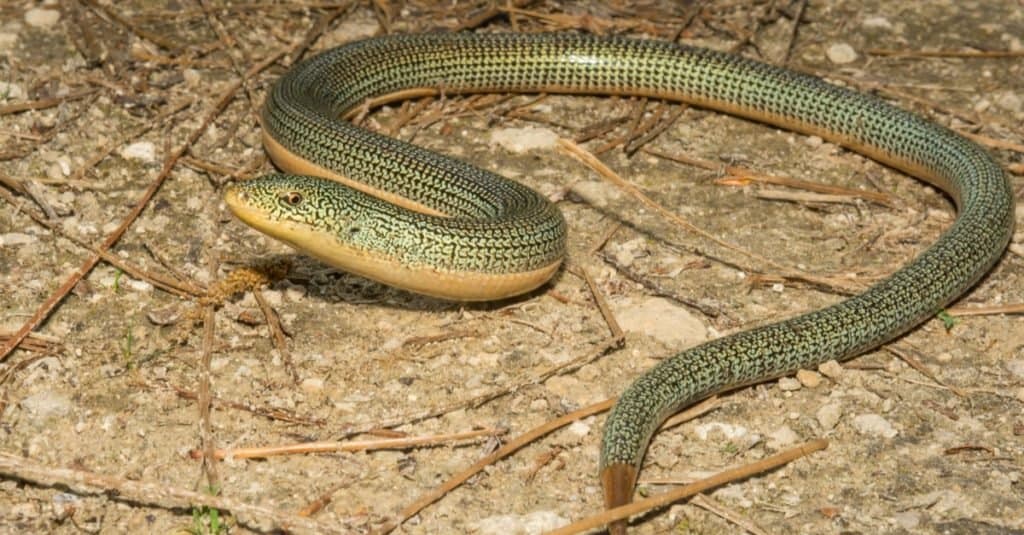
Glass lizards hibernate in the abandoned burrows of other animals.
©Jay Ondreicka/Shutterstock.com
These lizards are diurnal creatures that are typically active during moderate temperatures. In the spring and fall, they may be around at all times of the day. In the summer, they tend to be active during the morning and evening. The lizards hibernate during the winter months; don’t expect to see one between October and May.
Although they hibernate, glass lizards don’t actually dig their own burrows. Instead, they find abandoned burrows left behind by other animals. It’s unclear whether these lizards prefer to live alone or in groups, as these creatures are very good at fleeing when under observation.
Glass lizards are shy creatures but are not violent and may allow a human to approach them. The lizards do not bite when they feel threatened; instead, they try to escape. Like other lizards, members of the Ophisaurus family enjoy basking in the sun and may be found on large rocks or even sidewalks during the warmest part of the day.
Habitat
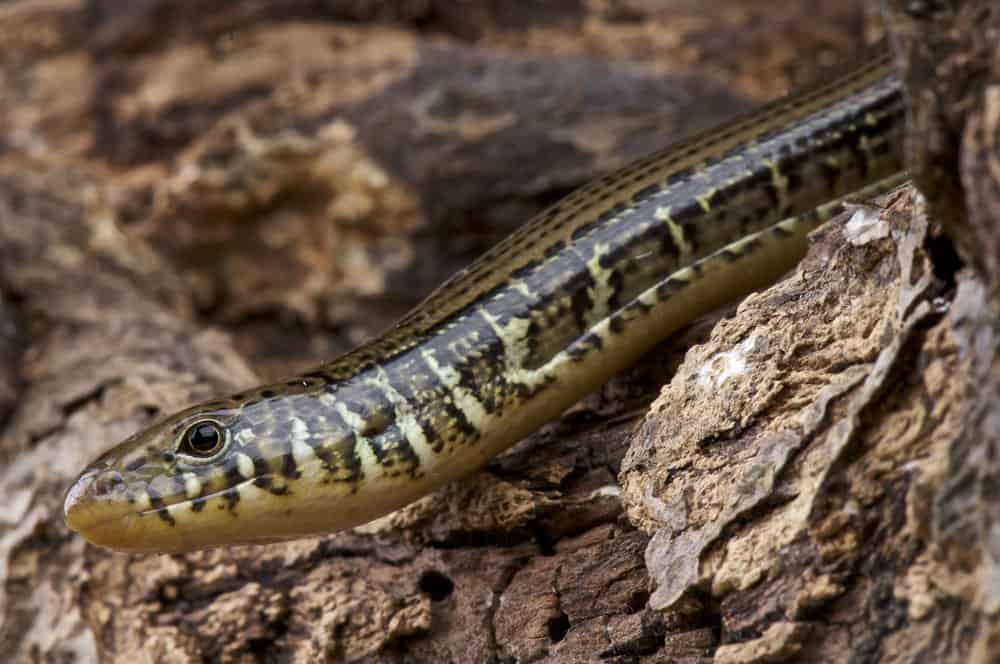
Glass lizards prefer a warm to moderate climate.
©reptiles4all/Shutterstock.com
These lizards are endemic to North America and are primarily found in warm to moderate regions, including the midwestern and southeastern parts of the country. Eastern glass lizards are widespread in Florida, Georgia, and the surrounding regions. They tend to prefer wetlands, sandy areas, and similar habitats. Meanwhile, the slender glass lizard prefers to live in the midwest and can be found in woodlands, grassy plains, and other areas with moderate temperatures and good cover.
Diet

The glass lizard, unlike a snake with unhinged jaws, can’t eat anything bigger than its open mouth.
©iStock.com/Dan Rieck
These lizards are carnivores that primarily eat insects like crickets and beetles. However, they also hunt other small creatures, including spiders, rodents, snakes, and even other lizards. They primarily hunt underground but may also look for food in dark, damp areas on the surface.
One of the main differences between these lizards and snakes is that glass lizards cannot unhinge their jaws. This means that the lizard cannot eat anything larger than the size of its head. Even the biggest lizards never weigh more than 21 ounces, which makes mice some of their largest possible prey.
Predators and Threats

Hawks prey on glass lizards.
©iStock.com/Holcy
The lizard’s natural predators vary based on the region. In general, they avoid raccoons, opossums, hawks, and other carnivorous mammals and birds of prey. Some types of snakes have also been known to feed on these lizards, including copperheads and king snakes.
One of the greatest threats to their survival is habitat disruption caused by humans. Deforestation and paving are the biggest concerns; however, insecticides also pose a substantial threat. If these lizards consume a bug that has ingested pesticides, the lizard may also fall victim to the poison.
Reproduction, Babies, and Lifespan
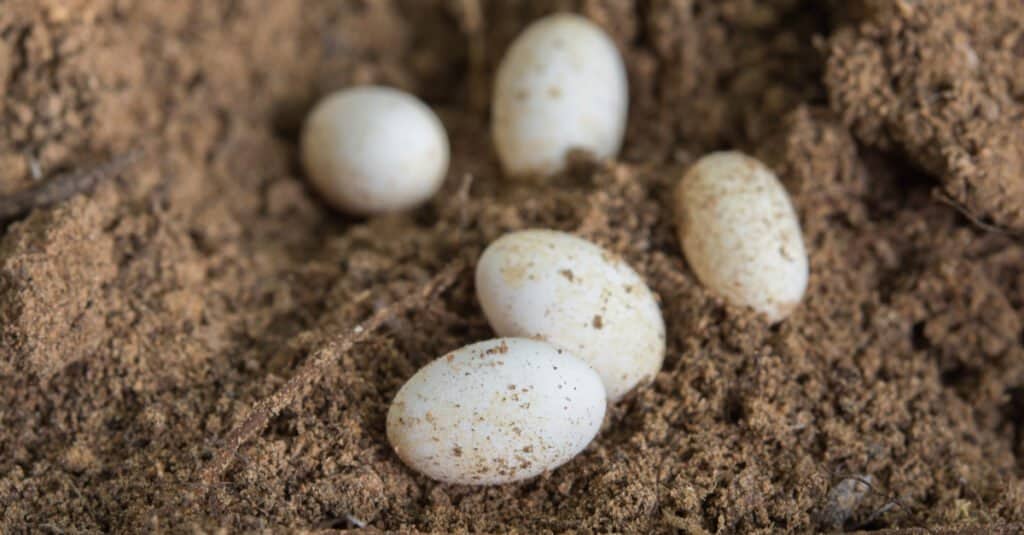
Female glass lizards stay with their eggs until they are hatched – unlike most lizards.
©srisakorn wonglakorn/Shutterstock.com
These lizards are egg-laying creatures that mate on a yearly or bi-yearly basis. The Ophisaurus mating season typically occurs in May, although this may vary based on the speed at which warm weather arrives.
After mating, female lizards carry their eggs for one to two months; the clutch of eggs is usually laid in late June or early July. An Ophisaurus clutch typically contains anywhere from 5 to 15 eggs. The mother lizard usually chooses a safe location underneath a covered object like a log or a rock.
Ophisaurus eggs will hatch after roughly 50 days. Female lizards stay with their eggs for this entire time period, a feature that is uncommon among most species of lizard. Freshly hatched lizards are only a few inches long and may need help feeding themselves until they are larger.
These lizards are sexually mature at 3 to 4 years of age. The average lifespan of a glass lizard is 10 years, but some have been known to survive for as long as 30 years. It is rare for this lizard to go its entire life without needing to regrow its tail, which is why there are no recorded instances of the lizard getting more than 4 feet long.
Population
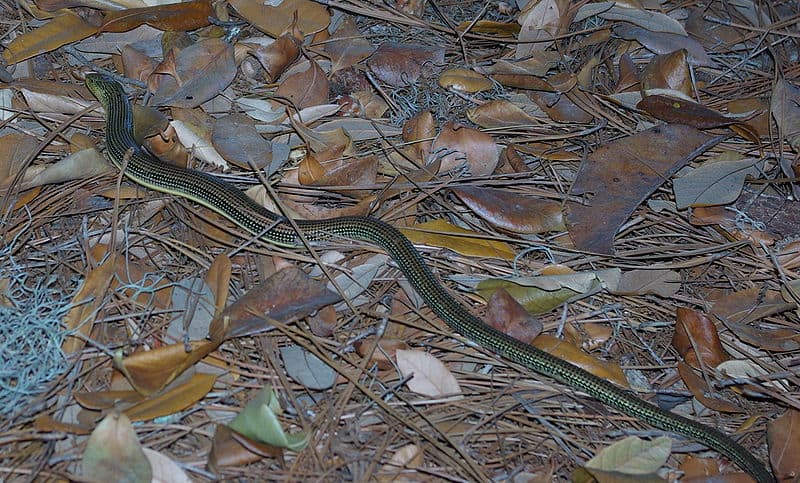
Glass lizards have a conservation status of least concern.
These lizards are not an endangered species. In fact, the International Union for Conservation of Nature has classified Ophisaurus as a least concern species because they have no immediate threats.
With that said, these lizards are still threatened by the encroachment of human populations on their existing habitats. The lizard populations have been dropping across the Midwest, and they are even considered endangered in the state of Wyoming
In the Zoo
These lizards are common enough to be featured in zoos around the world. From small zoos like the one at Chehaw Park to more prominent locations like Florida’s Jacksonville Zoo and Gardens, Ophisaurus can be found in nearly any well-established reptile house.
View all 170 animals that start with GGlass Lizard FAQs (Frequently Asked Questions)
What do glass lizards eat?
Glass lizards primarily eat insects, spiders, and other small creatures. A glass lizard can’t eat anything larger than its head, which is why you won’t see one eating birds or larger rodents. However, you might see a glass lizard eating a snake or even another kind of lizard.
Are glass lizards carnivores, herbivores, or omnivores?
Glass lizards are carnivores. They hunt for bugs and other prey underground or in places where there is plenty of cover.
Where do glass lizards live?
Glass lizards live in moderate climate regions across North America. Eastern glass lizards are commonly found in Florida, and slender glass lizards are usually found in the Midwest.
Are glass lizards venomous?
Glass lizards are not venomous or poisonous. They aren’t known for biting, and their jaws are not powerful enough to break human skin.
Do glass lizards make good pets?
Glass lizards are shy but even-tempered creatures, and they can make good pets if they are treated well. Remember that an Ophisaurus is fragile; if you handle it incorrectly, you could break its tail.
How big do glass lizards get?
Glass lizards have been known to grow to lengths of up to 4 feet. Most of this length is tail; if the tail breaks off during a fight, it will eventually regrow.
Why is a glass lizard not a snake?
An Ophisaurus is a legless lizard that looks a lot like a snake. However, if you check their faces, you’ll immediately notice that glass lizards have eyes that can open and close. They also have ear holes and stiff bodies – both features that snakes do not have. Finally, some glass lizards actually have small legs near their rear vents.
What Kingdom do Glass Lizards belong to?
Glass Lizards belong to the Kingdom Animalia.
What phylum to Glass Lizards belong to?
Glass Lizards belong to the phylum Chordata.
What family do Glass Lizards belong to?
Glass Lizards belong to the family Anguidae.
What order do Glass Lizards belong to?
Glass Lizards belong to the order Squamata.
What genus do Glass Lizards belong to?
Glass Lizards belong to the genus Ophisaurus.
What type of covering do Glass Lizards have?
Glass Lizards are covered in Scales.
What are some predators of Glass Lizards?
Predators of Glass Lizards include birds, mammals, and snakes.
What are some distinguishing features of Glass Lizards?
Glass Lizards have forked tongues and detachable tails.
How many eggs do Glass Lizards lay?
Glass Lizards typically lay 6 eggs.
What is an interesting fact about Glass Lizards?
Glass Lizards can grow up to 4ft long!
What is the scientific name for the Glass Lizard?
The scientific name for the Glass Lizard is Ophisaurus.
What is the lifespan of a Glass Lizard?
Glass Lizards can live for 10 to 30 years.
How fast is a Glass Lizard?
A Glass Lizard can travel at speeds of up to 6 miles per hour.
Thank you for reading! Have some feedback for us? Contact the AZ Animals editorial team.
Sources
- David Burnie, Dorling Kindersley (2011) Animal, The Definitive Visual Guide To The World's Wildlife
- Tom Jackson, Lorenz Books (2007) The World Encyclopedia Of Animals
- David Burnie, Kingfisher (2011) The Kingfisher Animal Encyclopedia
- Richard Mackay, University of California Press (2009) The Atlas Of Endangered Species
- David Burnie, Dorling Kindersley (2008) Illustrated Encyclopedia Of Animals
- Dorling Kindersley (2006) Dorling Kindersley Encyclopedia Of Animals
- Snakes Are Long, Available here: http://snakesarelong.blogspot.com/2012/04/lizards-of-glass.html
- Virginia Herpetological Society, Available here: https://www.virginiaherpetologicalsociety.com/reptiles/lizards/eastern-glass-lizard/eastern_glass_lizard.php
- Britannica, Available here: https://www.britannica.com/animal/glass-lizard










